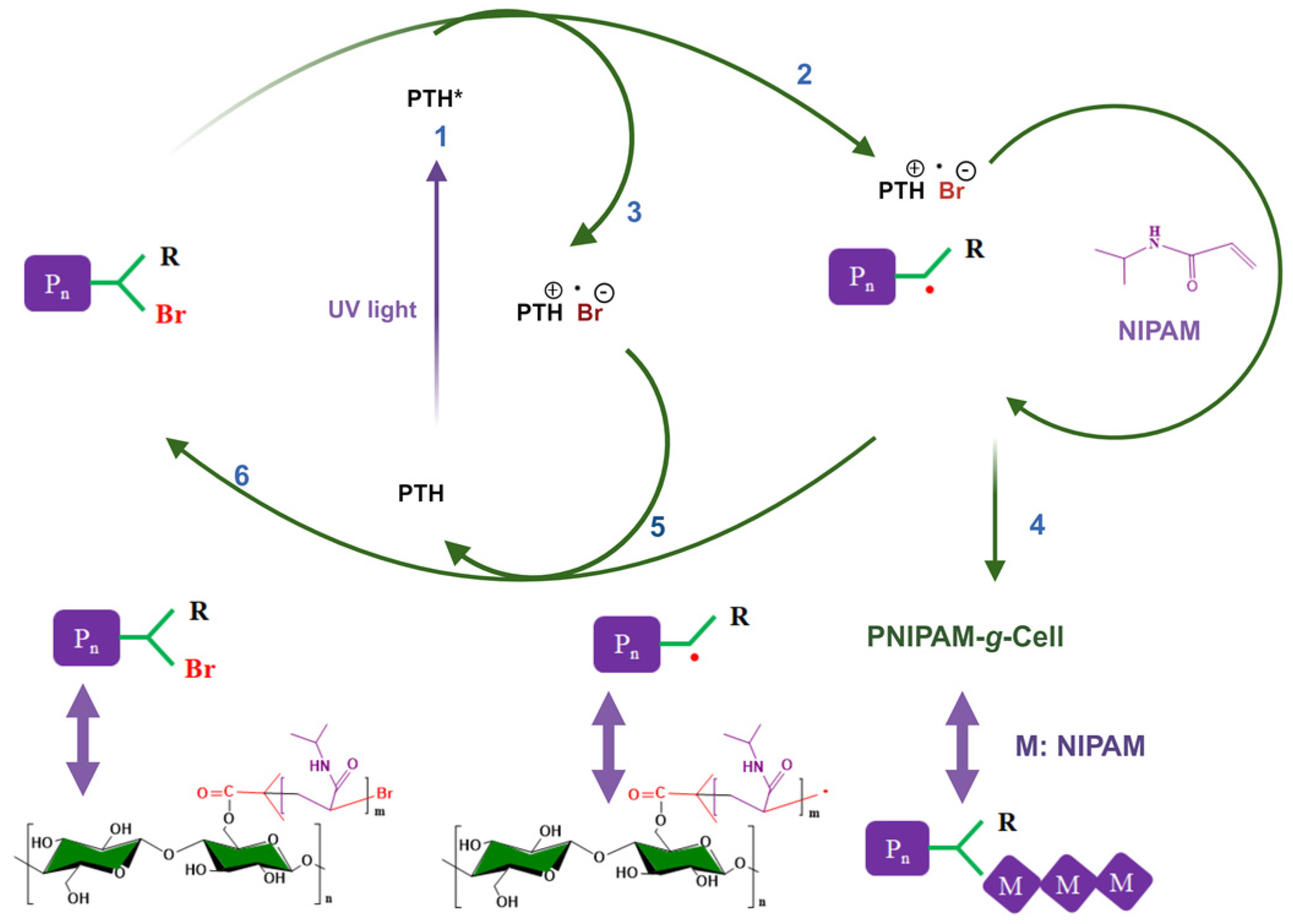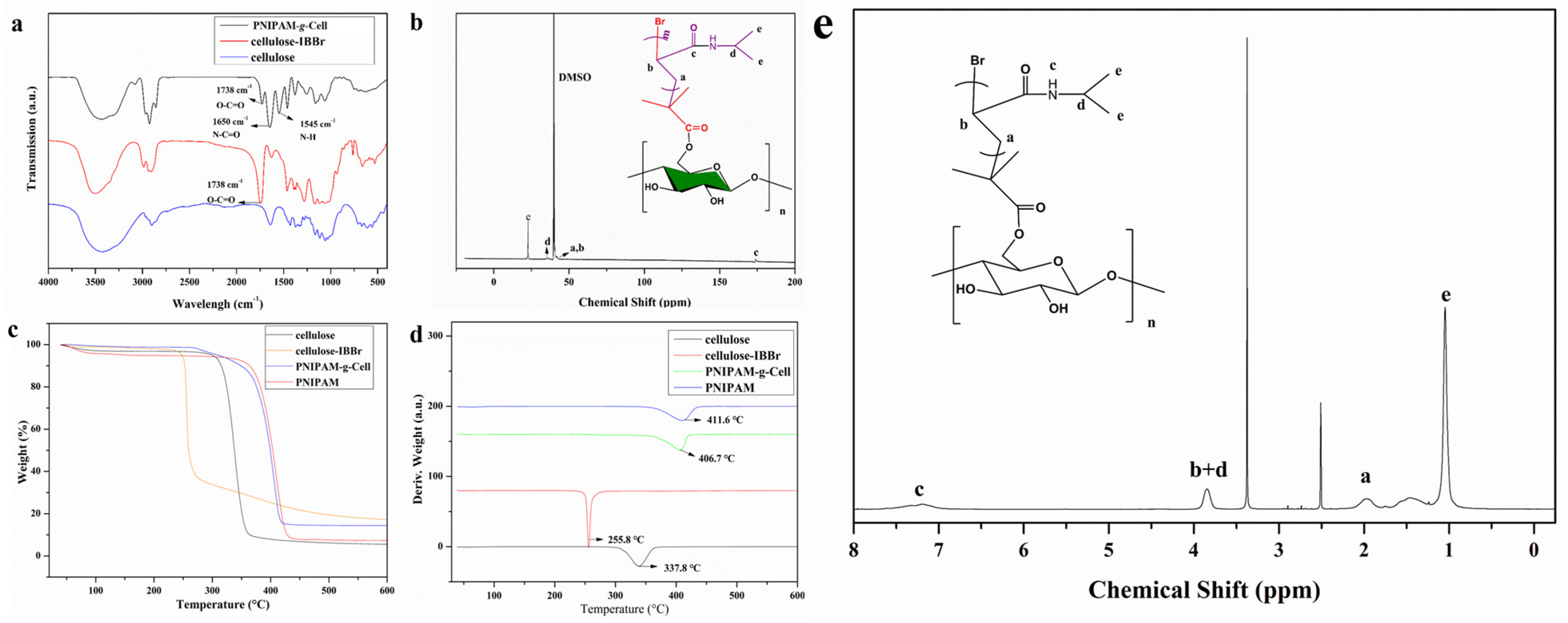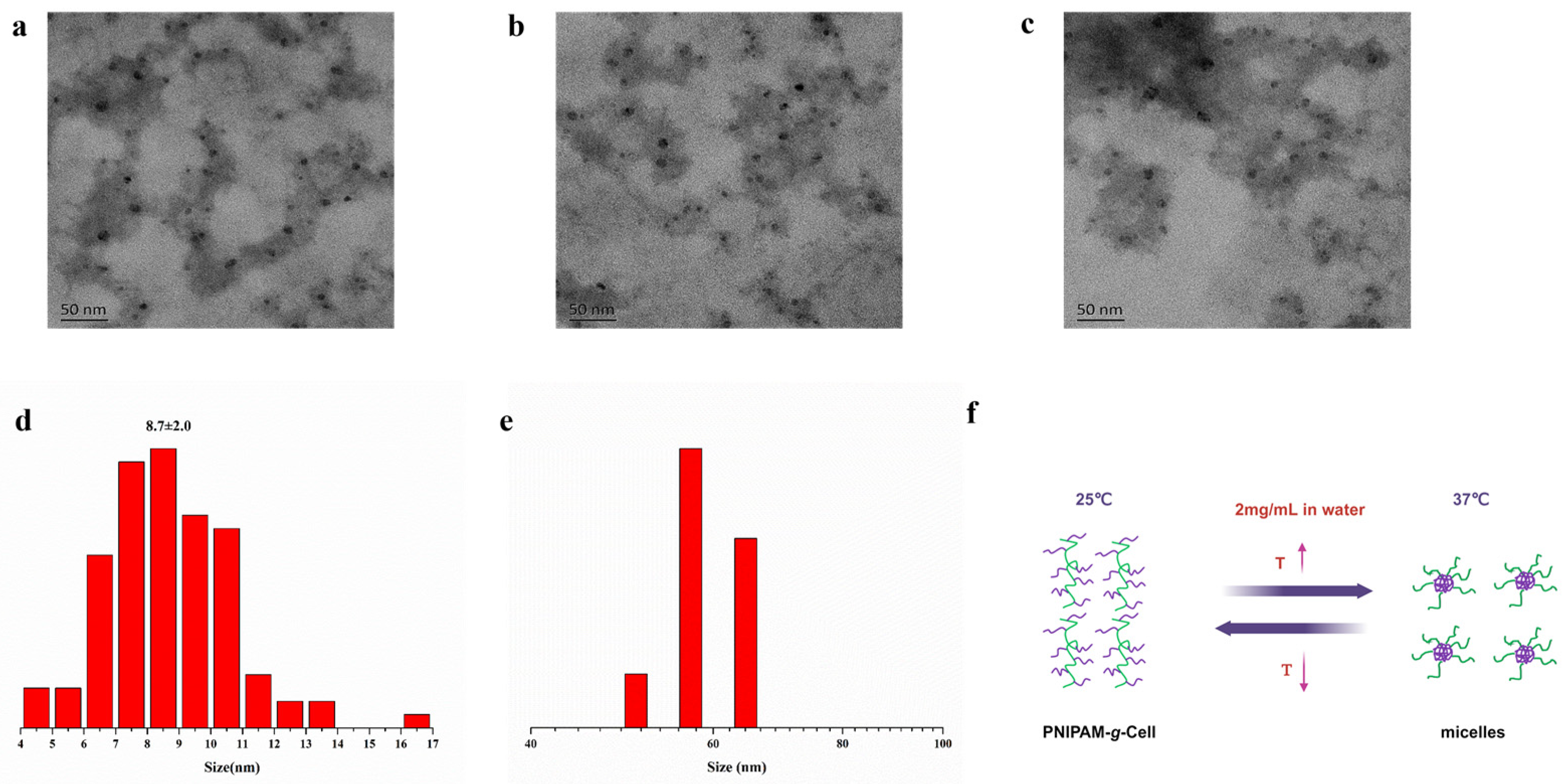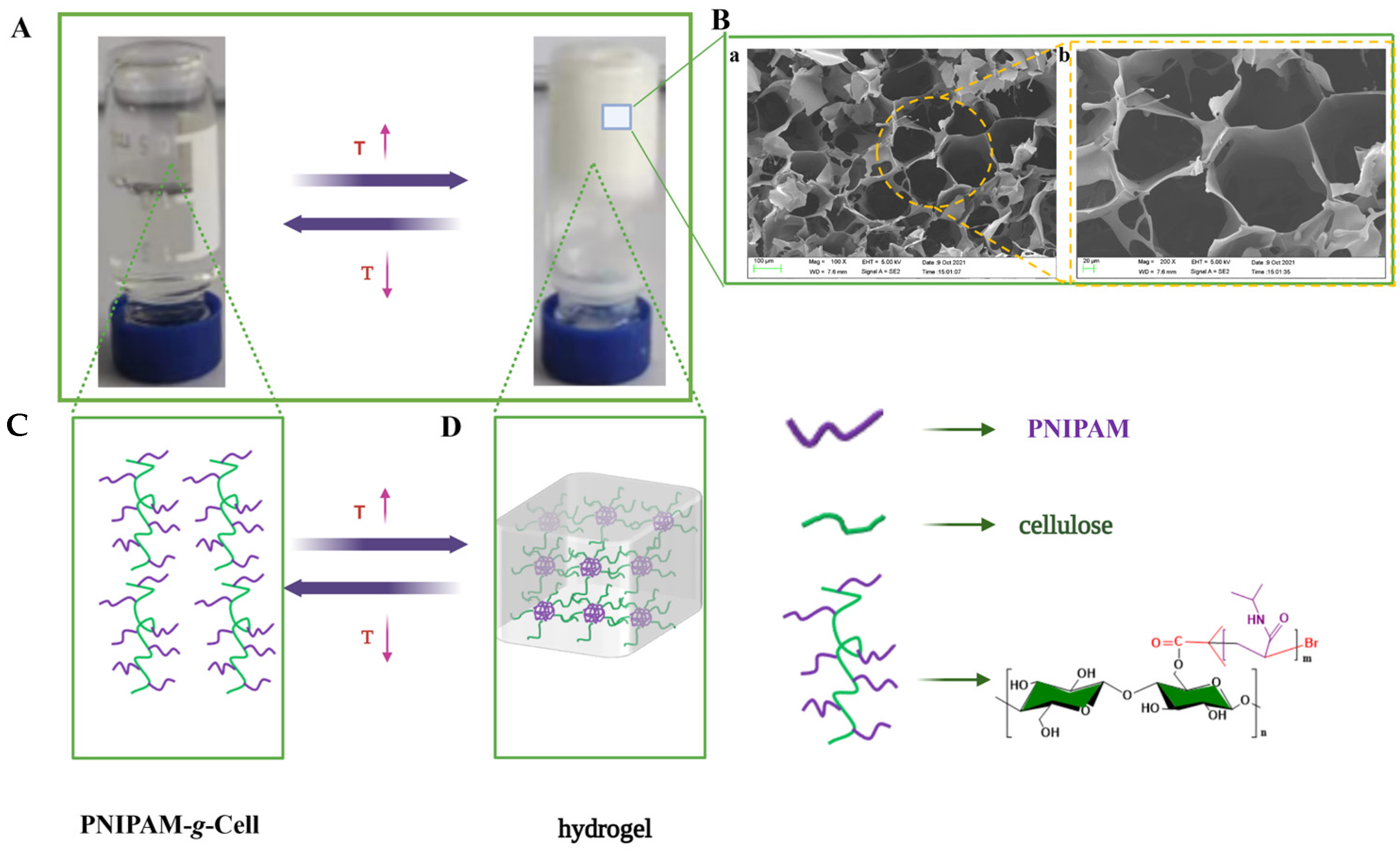Photoinduced Metal-Free Atom Transfer Radical Polymerization for the Modification of Cellulose with Poly(N-isopropylacrylamide) to Create Thermo-Responsive Injectable Hydrogels
Abstract
:1. Introduction
2. Results and Discussion
2.1. Synthesis and Characterization of PNIPAM-g-Cell
2.2. The Self-Assembly Behavior of PNIPAM-g-Cell
2.3. The Sol–Gel Properties and Morphology of PNIPAM-g-Cell Injectable Hydrogels
2.4. Mechanical Properties of PNIPAM-g-Cell Injectable Hydrogels
2.5. In Vitro Release of DOX from PNIPAM-g-Cell Injectable Hydrogels and Their Biocompatibility
3. Materials and Methods
3.1. Materials
3.2. Characterization
3.3. Methods
3.3.1. The Dissolution of MCC
3.3.2. Synthesis of PNIPAM-g-Cell Copolymer
3.3.3. GPC
3.3.4. Sol–Gel Transition
3.3.5. The In Vitro Study of the Release of DOX from PNIPAM-g-Cell Injectable Thermos-Responsive Hydrogel
3.3.6. The Mechanical Properties of the Injectable Hydrogel Composed of PNIPAM-g-Cell
3.3.7. The Cytocompatibility of the Cellulose-Based Injectable Thermo-Responsive Hydrogel
4. Conclusions
Author Contributions
Funding
Data Availability Statement
Conflicts of Interest
Abbreviations
| RAFT | Reversible addition–fragmentation chain transfer polymerization |
| BIBB | 2-Bromoisobuturyl bromide |
| ARGET | Activators regenerated by electron transfer |
| NMP | Nitroxide-mediated polymerization |
| MCC | Microcrystalline cellulose |
| LiCl | Anhydrous lithium chloride |
| DMAc | N,N-dimethylacetamide |
| NIPAM | N-isopropylarcylamide |
| DMSO | Dimethylsulfoxide |
| PBS | Phosphate-buffered solution |
| DOX | Doxorubicin |
| LCST | Lower critical solution temperature |
| ATRP | Atom transfer radical polymerization |
| FTIR | Fourier transform infrared spectroscopy |
| TEM | Transmission electron microscope |
| SEM | Scanning electron microscope |
| DLS | Dynamic light scattering |
| TGA | Thermogravimetric analysis |
References
- Credou, J.; Berthelot, T. Cellulose: From Biocompatible to Bioactive Material. J. Mater. Chem. B 2014, 2, 4767–4788. [Google Scholar] [CrossRef] [PubMed]
- Yuan, W.; Zou, H.; Shen, J. Amphiphilic Graft Copolymers with Ethyl Cellulose Backbone: Synthesis, Self-Assembly and Tunable Temperature–CO2 Response. Carbohydr. Polym. 2016, 136, 216–223. [Google Scholar] [CrossRef] [PubMed]
- Habibi, Y. Key Advances in the Chemical Modification of Nanocelluloses. Chem. Soc. Rev. 2014, 43, 1519–1542. [Google Scholar] [CrossRef] [PubMed]
- Morits, M.; McKee, J.R.; Majoinen, J.; Malho, J.-M.; Houbenov, N.; Seitsonen, J.; Laine, J.; Gröschel, A.H.; Ikkala, O. Polymer Brushes on Cellulose Nanofibers: Modification, SI-ATRP, and Unexpected Degradation Processes. ACS Sustain. Chem. Eng. 2017, 5, 7642–7650. [Google Scholar] [CrossRef]
- Zoppe, J.O.; Ataman, N.C.; Mocny, P.; Wang, J.; Moraes, J.; Klok, H.-A. Surface-Initiated Controlled Radical Polymerization: State-of-the-Art, Opportunities, and Challenges in Surface and Interface Engineering with Polymer Brushes. Chem. Rev. 2017, 117, 1105–1318. [Google Scholar] [CrossRef] [PubMed]
- Yang, H.; Ang, M.; Tsai, H.; Lee, K.; Lai, J. Effect of Adding Carbon Quantum Dots to a NMP Solution of Cellulose Acetate on the Formation Mechanism of Ensuing Membrane. J. Taiwan Inst. Chem. Eng. 2022, 133, 104250. [Google Scholar] [CrossRef]
- Assem, Y.; Abou-Zeid, R.; Kamel, S.; Ali, K. Metal Ions Adsorption by RAFT-Modified Cellulose. KGK-Kautschuk Gummi Kunststoffe 2022, 75, 58–63. [Google Scholar]
- Mahyari, M.; Khodadadipoor, Z.; Feiz, E.; Zarei, M.; Gavgani, J. Preparation of Copper (I) Chelated Strip Catalysts Based on PEI Immobilized on Graphene-Coated Bacterial Cellulose for ATRP Reaction. Arab. J. Sci. Eng. 2023, 49, 565–575. [Google Scholar] [CrossRef]
- Yin, Y.; Tian, X.; Jiang, X.; Zhu, P. Modification of Cellulose Nanocrystals via Surface-Initiated ARGET ATRP and Their Reinforcement of Poly(Lactic Acid)-Based Biocomposites. Ind. Crops Prod. 2022, 188, 115575. [Google Scholar] [CrossRef]
- Cheng, Y.; Xia, Q.; Liu, H.; Solomon, M.; Ling, C.; Müllner, M. Polymer Brush-Grafted Cellulose Nanocrystals for the Synthesis of Porous Carbon-Coated Titania Nanocomposites. Polym. Chem. 2023, 14, 2181–2189. [Google Scholar] [CrossRef]
- Corbin, D.; Miyake, G. Photoinduced Organocatalyzed Atom Transfer Radical Polymerization (O-ATRP): Precision Polymer Synthesis Using Organic Photoredox Catalysis. Chem. Rev. 2022, 122, 1830–1874. [Google Scholar] [CrossRef] [PubMed]
- Chism, K.; Corbin, D.; Miyake, G. Removal of Photoredox Catalysts from Polymers Synthesized by Organocatalyzed Atom Transfer Radical Polymerization. J. Polym. Sci. 2022, 60, 2747–2755. [Google Scholar] [CrossRef] [PubMed]
- Treat, N.J.; Sprafke, H.; Kramer, J.W.; Clark, P.G.; Barton, B.E.; Read de Alaniz, J.; Fors, B.P.; Hawker, C.J. Metal-Free Atom Transfer Radical Polymerization. J. Am. Chem. Soc. 2014, 136, 16096–16101. [Google Scholar] [CrossRef] [PubMed]
- Pan, X.; Fang, C.; Fantin, M.; Malhotra, N.; So, W.Y.; Peteanu, L.A.; Isse, A.A.; Gennaro, A.; Liu, P.; Matyjaszewski, K. Mechanism of Photoinduced Metal-Free Atom Transfer Radical Polymerization: Experimental and Computational Studies. J. Am. Chem. Soc. 2016, 138, 2411–2425. [Google Scholar] [CrossRef] [PubMed]
- Lu, C.; Wang, C.; Yu, J.; Wang, J.; Chu, F. Metal-Free ATRP “Grafting from” Technique for Renewable Cellulose Graft Copolymers. Green Chem. 2019, 21, 2759–2770. [Google Scholar] [CrossRef]
- Chen, J.; Mao, L.; Qi, H.; Xu, D.; Huang, H.; Liu, M.; Wen, Y.; Deng, F.; Zhang, X.; Wei, Y. Preparation of Fluorescent Cellulose Nanocrystal Polymer Composites with Thermo-Responsiveness through Light-Induced ATRP. Cellulose 2020, 27, 743–753. [Google Scholar] [CrossRef]
- Shanmugam, S.; Boyer, C. Organic Photocatalysts for Cleaner Polymer Synthesis. Science 2016, 352, 1053–1054. [Google Scholar] [CrossRef]
- Sui, X.; Yuan, J.; Zhou, M.; Zhang, J.; Yang, H.; Yuan, W.; Wei, Y.; Pan, C. Synthesis of Cellulose-Graft-Poly(N,N-Dimethylamino-2-Ethyl Methacrylate) Copolymers via Homogeneous ATRP and Their Aggregates in Aqueous Media. Biomacromolecules 2008, 9, 2615–2620. [Google Scholar] [CrossRef]
- Wang, Z.; Zhang, Y.; Jiang, F.; Fang, H.; Wang, Z. Synthesis and Characterization of Designed Cellulose-Graft-Polyisoprene Copolymers. Polym. Chem. 2014, 5, 3379–3388. [Google Scholar] [CrossRef]
- Ifuku, S.; Kadla, J.F. Preparation of a Thermosensitive Highly Regioselective Cellulose/N-Isopropylacrylamide Copolymer through Atom Transfer Radical Polymerization. Biomacromolecules 2008, 9, 3308–3313. [Google Scholar] [CrossRef] [PubMed]
- Wu, W.; Huang, F.; Pan, S.; Mu, W.; Meng, X.; Yang, H.; Xu, Z.; Ragauskas, A.; Deng, Y. Thermo-Responsive and Fluorescent Cellulose Nanocrystals Grafted with Polymer Brushes. J. Mater. Chem. A 2014, 3, 1995–2005. [Google Scholar] [CrossRef]
- Fan, Z.; Liu, B.; Wang, J.; Zhang, S.; Lin, Q.; Gong, P.; Ma, L.; Yang, S. A Novel Wound Dressing Based on Ag/Graphene Polymer Hydrogel: Effectively Kill Bacteria and Accelerate Wound Healing. Adv. Funct. Mater. 2014, 24, 3933–3943. [Google Scholar] [CrossRef]
- You, J.; Cao, J.; Zhao, Y.; Zhang, L.; Zhou, J.; Chen, Y. Improved Mechanical Properties and Sustained Release Behavior of Cationic Cellulose Nanocrystals Reinforeced Cationic Cellulose Injectable Hydrogels. Biomacromolecules 2016, 17, 2839–2848. [Google Scholar] [CrossRef]
- Yang, X.; Bakaic, E.; Hoare, T.; Cranston, E.D. Injectable Polysaccharide Hydrogels Reinforced with Cellulose Nanocrystals: Morphology, Rheology, Degradation, and Cytotoxicity. Biomacromolecules 2013, 14, 4447–4455. [Google Scholar] [CrossRef] [PubMed]
- Shi, L.; Han, Y.; Hilborn, J.; Ossipov, D. “Smart” Drug Loaded Nanoparticle Delivery from a Self-Healing Hydrogel Enabled by Dynamic Magnesium–Biopolymer Chemistry. Chem. Commun. 2016, 52, 11151–11154. [Google Scholar] [CrossRef] [PubMed]
- Omidi, S.; Pirhayati, M.; Kakanejadifard, A. Co-Delivery of Doxorubicin and Curcumin by a pH-Sensitive, Injectable, and in Situ Hydrogel Composed of Chitosan, Graphene, and Cellulose Nanowhisker. Carbohydr. Polym. 2020, 231, 115745. [Google Scholar] [CrossRef]
- Wang, J.; Zhou, X.; Xiao, H. Structure and Properties of Cellulose/Poly(N-Isopropylacrylamide) Hydrogels Prepared by SIPN Strategy. Carbohydr. Polym. 2013, 94, 749–754. [Google Scholar] [CrossRef]
- Chang, F.; Yamabuki, K.; Onimura, K.; Oishi, T. Modification of Cellulose by Using Atom Transfer Radical Polymerization and Ring-Opening Polymerization. Polym. J. 2008, 40, 1170–1179. [Google Scholar] [CrossRef]
- Lin, C.; Zhan, H.; Liu, M.; Fu, S.; Zhang, J. Preparation of Cellulose Graft Poly(Methyl Methacrylate) Copolymers by Atom Transfer Radical Polymerization in an Ionic Liquid. Carbohydr. Polym. 2009, 78, 432–438. [Google Scholar] [CrossRef]
- Liu, X.; Li, M.; Zhang, H.; Chen, L.; Fu, S. An Injectable Thermo-Responsive Hydrogel Based Cellulose-Brush Derivative for the Sustained Release of Doxorubicin. Cellulose 2021, 28, 1587–1597. [Google Scholar] [CrossRef]
- Liu, X.; Li, M.; Zheng, X.; Retulainen, E.; Fu, S. Dual Light- and pH-Responsive Composite of Polyazo-Derivative Grafted Cellulose Nanocrystals. Materials 2018, 11, 1725. [Google Scholar] [CrossRef] [PubMed]







Disclaimer/Publisher’s Note: The statements, opinions and data contained in all publications are solely those of the individual author(s) and contributor(s) and not of MDPI and/or the editor(s). MDPI and/or the editor(s) disclaim responsibility for any injury to people or property resulting from any ideas, methods, instructions or products referred to in the content. |
© 2024 by the authors. Licensee MDPI, Basel, Switzerland. This article is an open access article distributed under the terms and conditions of the Creative Commons Attribution (CC BY) license (https://creativecommons.org/licenses/by/4.0/).
Share and Cite
Liu, X.; Shen, J.; Wang, Y.; Li, M.; Fu, S. Photoinduced Metal-Free Atom Transfer Radical Polymerization for the Modification of Cellulose with Poly(N-isopropylacrylamide) to Create Thermo-Responsive Injectable Hydrogels. Int. J. Mol. Sci. 2024, 25, 2867. https://doi.org/10.3390/ijms25052867
Liu X, Shen J, Wang Y, Li M, Fu S. Photoinduced Metal-Free Atom Transfer Radical Polymerization for the Modification of Cellulose with Poly(N-isopropylacrylamide) to Create Thermo-Responsive Injectable Hydrogels. International Journal of Molecular Sciences. 2024; 25(5):2867. https://doi.org/10.3390/ijms25052867
Chicago/Turabian StyleLiu, Xiaohong, Juanli Shen, Ying Wang, Ming Li, and Shiyu Fu. 2024. "Photoinduced Metal-Free Atom Transfer Radical Polymerization for the Modification of Cellulose with Poly(N-isopropylacrylamide) to Create Thermo-Responsive Injectable Hydrogels" International Journal of Molecular Sciences 25, no. 5: 2867. https://doi.org/10.3390/ijms25052867




